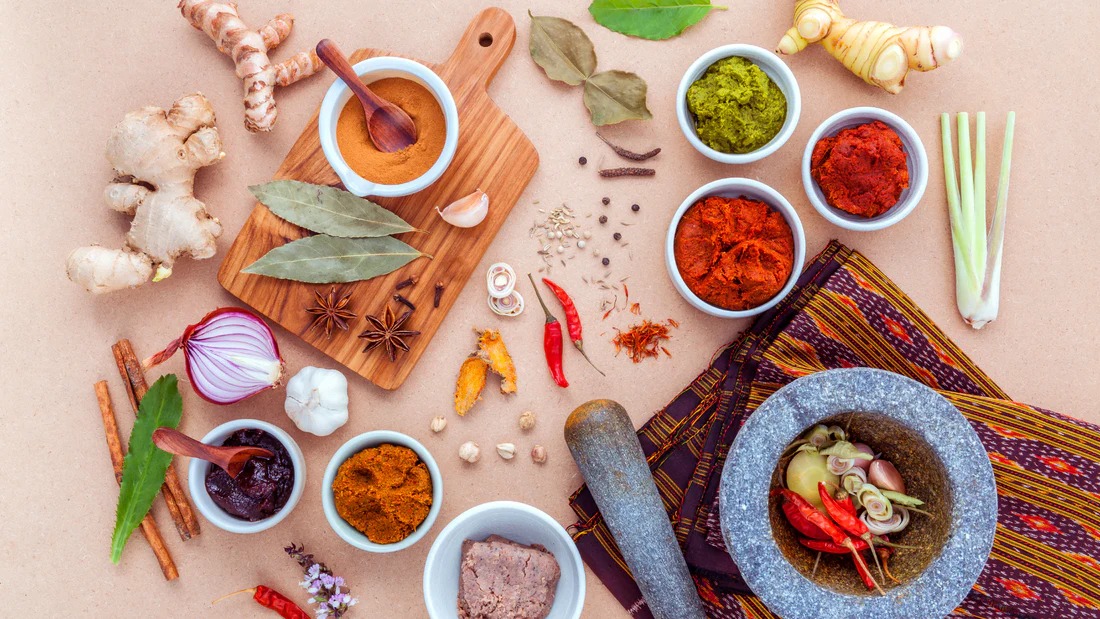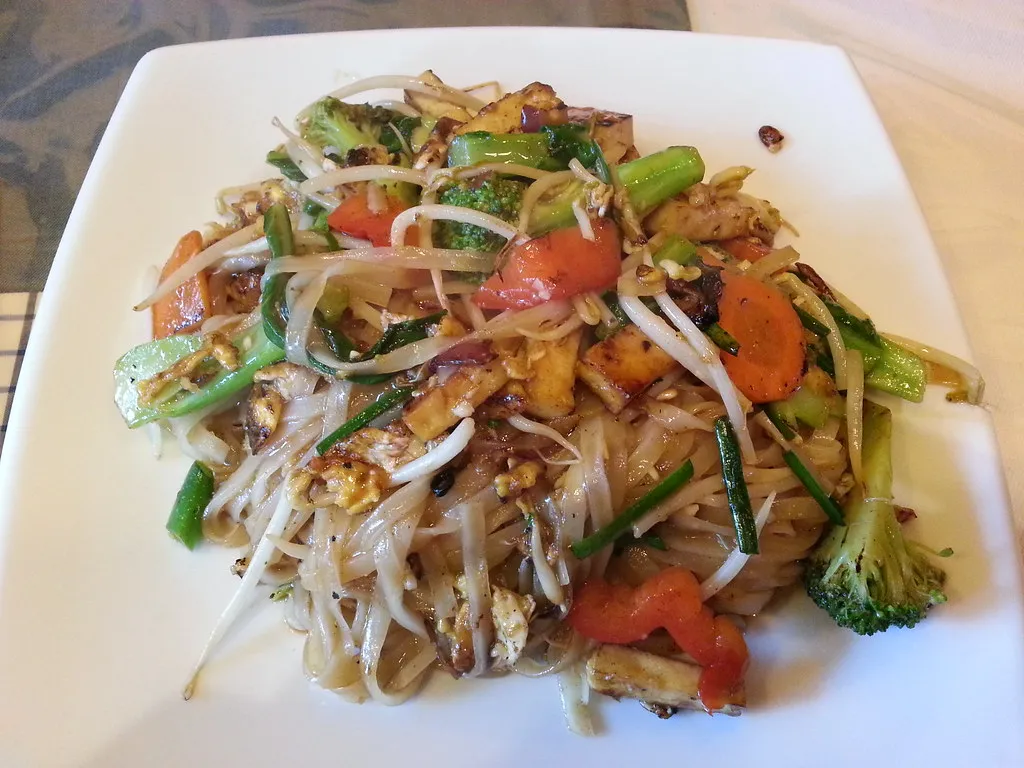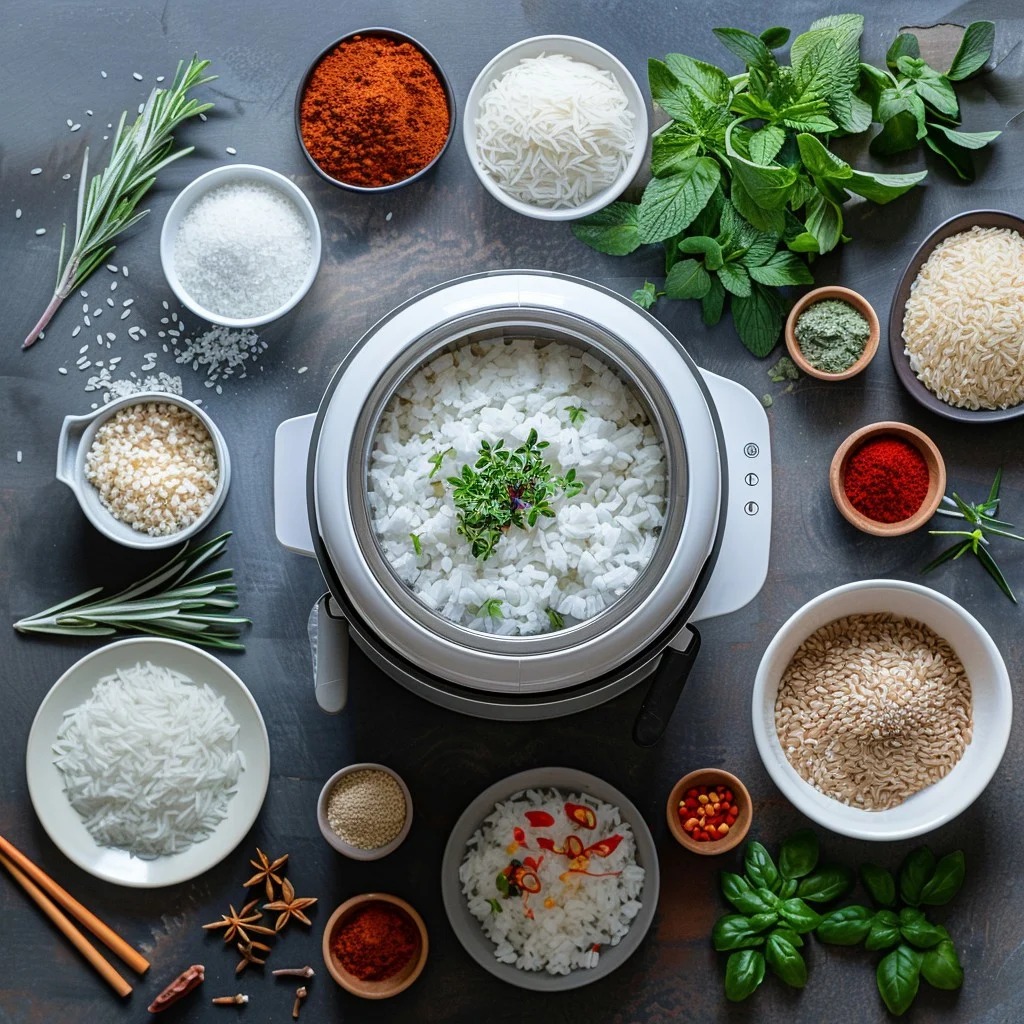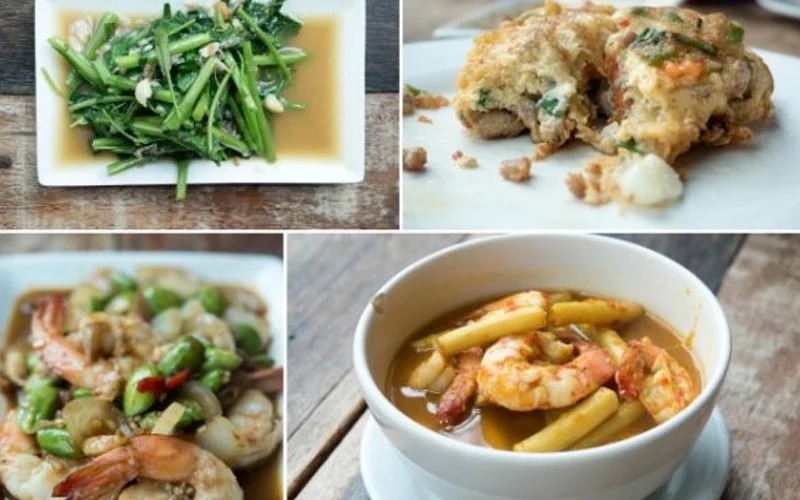The Best Fluffy Pancakes recipe you will fall in love with. Full of tips and tricks to help you make the best pancakes.
People around the world love Thai food for its bold flavors, vibrant colors, and aromatic spices. Whether you’ve indulged in a savory bowl of Tom Yum soup or savored the sweet and spicy notes of Pad Thai, it’s clear that Thai cuisine offers something truly special. At the heart of Thai cooking is the delicate balance of four key flavors: sweet, salty, sour, and spicy. Fresh chilies bring heat, and coconut milk adds richness, with every dish designed to awaken your taste buds in the most delightful way.
What makes Thai food so distinct is its use of fresh herbs and spices. Ingredients like lemongrass, kaffir lime leaves, and Thai basil create layers of flavor that bring the essence of Thailand right into your kitchen. Fortunately, cooking these mouthwatering dishes at home is easier than you might think. With the right ingredients and a few simple steps, you can recreate these authentic Thai recipes in your own kitchen, no matter your level of experience.
In this blog post, we’ll explore easy and authentic Thai recipes that will help you bring the vibrant taste of Thailand into your home. Get ready to discover the essentials of Thai cooking, and let’s dive into the world of rich flavors and simple yet delicious dishes that are perfect for any home cook!
Must-Have Thai Spices and Herbs for Authentic Cooking
One of the hallmarks of Thai food is its incredible use of spices and herbs, which work together to create dishes bursting with bold, complex flavors. For home cooks looking to recreate authentic Thai dishes, stocking up on these essential ingredients is key. Let’s explore some of the most important spices and herbs that form the foundation of Thai cooking.

Fish Sauce: The Heart of Thai Flavor
Many Thai dishes use fish sauce, or nam pla, as the key ingredient and often rely on it as the primary source of salt. Made from fermented fish and salt, this pungent yet flavorful sauce provides the deep umami and salty kick that defines Thai food. It’s an essential part of dressings, marinades, soups, and stir-fries, adding complexity and richness to any dish. While it has a strong aroma, it mellows beautifully when cooked and combines with other flavors to create the characteristic Thai balance. Don’t be afraid to experiment with fish sauce, but remember that a little goes a long way!
Lemongrass: Citrus with a Subtle Depth
Chefs commonly use lemongrass in Thai cuisine to impart a bright, citrusy flavor with a slightly herbal undertone.. Typically used in soups, curries, and teas, lemongrass adds a fresh, zesty note that complements the heat of chilies and the richness of coconut milk. When preparing lemongrass for cooking, it’s essential to bruise the stalks with the back of a knife to release the oils, allowing its full flavor to infuse the dish. It pairs especially well with dishes like Tom Yum soup and green curry, bringing an aromatic complexity that’s key to authentic Thai taste.
Kaffir Lime Leaves: The Fragrant Leaf that Elevates Dishes
Kaffir lime leaves are a distinctive and aromatic herb used in Thai cooking to add a refreshing, citrusy fragrance to dishes. Chefs commonly use kaffir lime leaves in soups, curries, and stir-fries. Unlike regular lime zest, they don’t typically eat kaffir lime leaves but use them to infuse flavors into dishes during cooking.Their unique taste is bright, fragrant, and slightly bitter. To release the most flavor, you’ll want to tear or finely slice the leaves before adding them to your dish. They are essential for dishes like green curry and Thai stir-fried basil, giving them their signature aroma.
Thai Basil: A Bold Herb with a Sweet, Spicy Kick
While many types of basil are used in cooking around the world, Thai basil stands out because it has a spicy, slightly peppery flavor with hints of anise. Cooks often use this herb in Thai stir-fries and curries, adding a punch of flavor that balances the richness of coconut milk and the heat of chilies. Pad Kra Pao, a popular Thai stir-fry made with minced meat and basil, is a perfect example of this herb’s bold role in Thai cuisine. Thai basil is easily recognizable by its small, pointed leaves and purple stems, and it has a distinct aroma that sets it apart from sweet basil used in Western cooking.
Galangal: The Ginger Relative that Adds Warmth
People often compare galangal to ginger, but it’s actually a completely different root with a more complex, woodsy flavor. It is a key ingredient in many Thai curries and soups, imparting a mild spiciness and earthy heat. Galangal’s slightly citrusy and peppery notes make it a wonderful addition to dishes like Tom Kha Gai (Thai coconut soup). If you can’t find fresh galangal, you can often substitute it with ginger, but the flavor won’t be exactly the same. When using galangal, slice it thinly or bruise it to release the oils and infuse your dish with its unique aroma.
Chilies: Heat that Packs a Punch
No Thai dish would be complete without the signature heat that comes from Thai chilies. These small but mighty peppers are the backbone of many Thai dishes, adding fiery spice and flavor complexity. There are different varieties of Thai chilies, such as the tiny bird’s eye chili, which is incredibly hot, and the slightly milder long red chili. Chefs use fresh or dried Thai chilies in everything from curry pastes to stir-fries and sauces. If you’re not used to the heat, start slow and adjust the number of chilies you use based on your spice tolerance. You can finely chop Thai chilies, grind them into a paste, or use them whole to infuse dishes with heat and flavor.
These spices and herbs are not just ingredients—they are essential to capturing the essence of Thai food in your home kitchen. Whether you’re preparing a hearty curry, a tangy soup, or a flavorful stir-fry, incorporating these key ingredients will elevate your cooking and help you achieve the authentic Thai flavors that people around the world love.”
For a deeper understanding of Thai food and its rich cultural background, check out this insightful article from The Spruce Eats: Thai Food and Culture. It delves into how Thai cuisine has evolved and offers a broader perspective on its significance.
Easy Thai Recipes You Can Make at Home
One of the most exciting things about Thai food is how it achieves vibrant, complex flavors with just a few essential ingredients and simple techniques. While some Thai dishes may sound intimidating, they’re often surprisingly easy to make at home. Whether you’re a beginner or an experienced cook, these easy-to-follow recipes will allow you to recreate the bold tastes of Thailand in your own kitchen. Here are some classic and accessible Thai dishes that you can make in no time!

Pad Thai: A Delicious Stir-Fry with Bold Flavors
Pad Thai is one of the most famous Thai dishes and for good reason—it’s flavorful, filling, and incredibly versatile. This stir-fried noodle dish combines the perfect balance of sweet, salty, sour, and spicy flavors, which is characteristic of Thai cuisine. The key to a great Pad Thai is using the right balance of tamarind paste, fish sauce, and palm sugar to create a tangy yet sweet sauce that coats the noodles perfectly.
Ingredients:
- Rice noodles
- Tamarind paste
- Fish sauce
- Palm sugar
- Shrimp or chicken (or tofu for a vegetarian version)
- Bean sprouts, peanuts, and lime for garnish
Steps:
- Cook the rice noodles according to package instructions and set aside.
- In a wok or large skillet, heat oil and cook your protein choice (shrimp, chicken, or tofu) until browned.
- Add garlic, eggs, and a few tablespoons of Pad Thai sauce made from tamarind paste, fish sauce, and sugar.
- Toss the noodles in the sauce and cook until they’re coated and heated through.
- Garnish with bean sprouts, chopped peanuts, cilantro, and a squeeze of lime for that classic Pad Thai finish.
Tom Yum Soup: A Tangy and Spicy Delight
Tom Yum is a classic Thai soup known for its spicy and sour flavors. With the freshness of lemongrass, kaffir lime leaves, and galangal, this soup is both comforting and refreshing.Shrimp typically make the dish, but you can easily substitute chicken or tofu to suit your preferences. The broth comes from a flavorful combination of stock, fish sauce, lime juice, and fresh herbs.
Ingredients:
- Shrimp (or chicken/tofu)
- Lemongrass
- Kaffir lime leaves
- Galangal
- Fish sauce
- Lime juice
- Thai bird’s eye chilies
- Mushrooms and cilantro
Steps:
- In a pot, bring water or chicken broth to a simmer with lemongrass, kaffir lime leaves, and galangal.
- Add the shrimp (or your choice of protein) and cook until just done.
- Add fish sauce, lime juice, and chili for that authentic tangy-spicy flavor.
- Toss in mushrooms and fresh cilantro, and adjust the seasoning to taste.
Tom Yum soup is a staple in Thai households, and it’s quick to make while delivering an incredibly rich and satisfying flavor profile.
Green Curry: A Creamy, Spicy Thai Classic
Green curry is a delicious and aromatic dish that brings together the heat of fresh chilies with the richness of coconut milk.Green curry is one of the most iconic Thai curries, often made with chicken, beef, or tofu, and typically served with jasmine rice. The curry base comes from green curry paste, which chefs make from green chilies, garlic, ginger, lemongrass, and other herbs.Combined with coconut milk, it creates a creamy, flavorful sauce that’s perfect for soaking up with rice.
Ingredients:
- Green curry paste
- Coconut milk
- Chicken, beef, or tofu
- Eggplant, bell peppers, and basil
- Fish sauce, sugar, and lime juice for seasoning
Steps:
- Heat a little oil in a pot and sauté the green curry paste until fragrant.
- Add coconut milk, then bring the mixture to a simmer.
- Add your choice of protein and vegetables and let everything cook until tender.
- Season with fish sauce, sugar, and lime juice to balance the flavors.
- Garnish with fresh Thai basil leaves before serving.
Green curry can be adjusted to suit your spice preferences, and it’s an easy dish to prepare that offers a deeply comforting and creamy texture. For tips on creating the perfect green curry every time, check out our Thai Red Curry Recipe Secrets.
Thai Stir-Fry with Basil (Pad Kra Pao): A Flavorful and Quick Meal
Pad Kra Pao is a quick and simple stir-fry, yet it’s packed with flavor. This dish typically uses minced pork or chicken, which is stir-fried with garlic, chilies, and Thai basil leaves. The result is a savory, slightly spicy dish that’s often served over rice and topped with a fried egg for a complete meal. The basil adds a peppery, aromatic layer to the stir-fry, and the combination of fish sauce and soy sauce creates a satisfying umami base.
Ingredients:
- Ground pork, chicken, or tofu
- Thai basil
- Garlic and bird’s eye chilies
- Fish sauce, soy sauce, and sugar
- Fried egg (optional)
Steps:
- Heat oil in a wok and sauté garlic and chilies until fragrant.
- Add the ground meat (or tofu) and cook until browned.
- Stir in fish sauce, soy sauce, and sugar, and cook until the sauce thickens.
- Add the fresh basil leaves at the end, allowing them to wilt and infuse the dish with their fragrance.
- Serve over steamed rice with a fried egg on top.
This stir-fry is perfect for a quick weeknight dinner, and the basil provides a fresh, spicy kick that will transport your taste buds straight to Thailand.
Key Ingredients You Need for Thai Cooking
To truly bring the flavors of Thailand into your kitchen, it’s important to understand and stock the key ingredients that form the foundation of Thai cooking. While Thai food is known for its balance of sweet, salty, sour, and spicy, it’s the combination of unique ingredients that allows home cooks to recreate these complex flavors. Whether you’re preparing a simple stir-fry or a rich curry, having the right ingredients on hand will make all the difference. Here are the essential ingredients you’ll need for authentic Thai cooking.

Coconut Milk: The Creamy Base of Thai Curries
Coconut milk is a staple in Thai cuisine, providing a rich and creamy texture that balances the heat of chili peppers and the acidity of lime. It is used as a base for many dishes, especially curries like Green Curry and Massaman Curry, giving them a luxurious, velvety consistency. Coconut milk also imparts a subtle sweetness that complements spicy flavors. When shopping for coconut milk, make sure to select a high-quality, full-fat version for the richest taste. If you’re looking to reduce fat, you can use light coconut milk, though it may not have the same depth of flavor.
Common Uses:
- Curries (green, red, Massaman, and Panang)
- Soups like Tom Kha Gai (Thai coconut soup)
- Sauces and marinades
- Desserts like sticky rice with mango
Fish Sauce (Nam Pla): The Umami Boost
Fish sauce is a fundamental ingredient in Thai cooking, providing a salty, savory, and slightly tangy flavor that’s impossible to replicate. Made from fermented fish (usually anchovies) and salt, fish sauce is used to season soups, stir-fries, dips, and marinades. It’s not just a salt replacement—it’s a source of umami, the “fifth taste,” that adds depth to any dish. While its scent can be overpowering on its own, once incorporated into food, it mellows and creates the authentic Thai flavor profile that we love.
Common Uses:
- Stir-fries like Pad Thai or Pad Kra Pao
- Soups like Tom Yum
- Dips, dressings, and sauces (such as the sauce for Som Tum)
- Marinades for meats and seafood
Tamarind Paste: Sweet and Tangy Flavor
Tamarind paste is derived from the fruit of the tamarind tree and adds a distinct tartness and sweetness to Thai dishes. It’s an essential ingredient in many Thai recipes, particularly in sauces and curries. The paste brings a sour, fruity flavor that balances out the richness of coconut milk or the spiciness of chilies. It’s especially important for creating the characteristic tang in dishes like Pad Thai and Tom Yum soup.
Common Uses:
- Pad Thai (as a base for the sauce)
- Tom Yum soup (adds sourness to the broth)
- Marinades for grilling meats or seafood
- Sauces for dipping
Kaffir Lime Leaves: Fragrant Citrus Notes
Kaffir lime leaves are a must-have herb in Thai cooking, known for their fragrant citrus aroma and slightly bitter flavor. They’re typically used whole and removed from the dish before serving, as they don’t soften during cooking. The leaves impart a fresh, zesty note that enhances the flavor of curries, soups, and stir-fries. They are often paired with lemongrass and galangal to create an aromatic base for many Thai dishes.
Common Uses:
- Tom Kha Gai (Thai coconut soup)
- Green Curry and other curry dishes
- Stir-fries like Pad Thai
- Flavoring broths and sauces
Lemongrass: Fresh, Citrusy Flavor
Lemongrass is another essential herb that’s frequently used in Thai cuisine. Its citrusy, slightly sweet flavor adds a refreshing note to any dish. Lemongrass is typically used whole or bruised to release its oils, and it’s often added to soups, curries, and stir-fries. It pairs perfectly with other strong flavors like chili, garlic, and galangal, making it a vital ingredient for crafting the aromatic, layered taste that defines Thai food.
Common Uses:
- Tom Yum soup
- Green Curry and other curry pastes
- Stir-fries, marinades, and sauces
- Herbal teas or infusions
Thai Chilies (Bird’s Eye Chilies): The Heat Factor
No Thai dish would be complete without the signature heat from Thai chilies, especially the small but fiery bird’s eye chilies. These chilies are much hotter than many Western varieties, but their flavor is bright and fresh, making them the perfect addition to Thai dishes. Whether fresh, dried, or ground into a paste, Thai chilies are used to spice up curries, stir-fries, and soups. For those who prefer less heat, it’s easy to adjust the number of chilies in a dish to suit your spice tolerance.
Common Uses:
- Curries (like red curry and green curry)
- Tom Yum and other soups
- Stir-fries like Pad Kra Pao
- Dips and sauces, such as Nam Prik Nam Pla (a dipping sauce)
Palm Sugar: Sweetness with a Caramel Touch
Palm sugar is the traditional sweetener used in Thai cuisine. Unlike refined sugar, palm sugar is made from the sap of the sugar palm tree, and it has a rich, caramel-like flavor with hints of molasses. It’s often used in combination with fish sauce and lime juice to create the sweet-salty-sour balance that Thai dishes are known for. Palm sugar can be found in blocks or grated, and it’s an essential ingredient in dishes like Pad Thai and Thai desserts.
Common Uses:
- Pad Thai (for the sauce)
- Curry sauces and marinades
- Thai desserts like coconut sticky rice
- Dips and sauces for grilled meats
Rice (Jasmine and Sticky Rice): The Thai Meal Staple
Rice is the foundation of most Thai meals, serving as the perfect base for curries, stir-fries, and soups. Jasmine rice is the most common variety, prized for its delicate, floral aroma and slightly sticky texture. It pairs well with savory dishes and absorbs sauces beautifully. Sticky rice, also known as glutinous rice, is used primarily in northern and northeastern Thai cuisine, often paired with grilled meats or served with Thai desserts like mango sticky rice.
Common Uses:
- Jasmine rice: Served with curries, stir-fries, and soups
- Sticky rice: Accompanies grilled meats and Thai desserts
Tips for Authentic Thai Cooking at Home
Cooking authentic Thai food at home can feel like a challenge due to the complexity of flavors and the number of ingredients used. However, with the right knowledge and a few key tips, anyone can bring the vibrant and bold flavors of Thai cuisine into their own kitchen. Here are some expert tips to help you cook authentic Thai dishes that taste just like they came from a street food stall in Bangkok.

1. Focus on Balancing the Four Core Flavors
One of the defining characteristics of Thai food is the balance between the four core flavors: sweet, salty, sour, and spicy. Mastering this balance is essential for creating authentic Thai dishes. Each dish should have all of these elements, and they should work in harmony to enhance one another. If a dish is too sour, a little sugar or palm sugar can balance it out; if it’s too salty, a bit of lime or vinegar can add the necessary acidity.
Pro Tip: Start by tasting as you go, adjusting the seasoning gradually. For example, if your curry is too spicy, you can add coconut milk to soften the heat. Similarly, if your soup is too sour, add a small amount of sugar to balance the flavor.
2. Use Fresh Ingredients Whenever Possible
Thai cooking relies heavily on fresh herbs, vegetables, and spices. Using fresh ingredients will not only enhance the flavor but will also help you achieve that authentic Thai taste. For example, fresh lemongrass, galangal, and kaffir lime leaves will give your dishes a much more aromatic and vibrant flavor than dried or powdered versions.
Pro Tip: If you don’t have access to a local Asian market, many grocery stores now carry fresh Thai herbs in their international aisle. If fresh herbs aren’t available, try to find high-quality frozen or dried alternatives.
3. Invest in a Mortar and Pestle
A mortar and pestle (or krok in Thai) is an indispensable tool in Thai cooking. It’s used to grind fresh spices and herbs into pastes, which form the base for many curries, soups, and sauces. The traditional method of grinding ingredients by hand creates a smoother paste with a more complex flavor than store-bought versions.
Pro Tip: When making a Thai curry paste, try using a combination of chili peppers, lemongrass, garlic, galangal, shallots, coriander roots, and cumin. Grind these ingredients in a mortar and pestle to release their essential oils and flavors, creating a fresh, aromatic paste that elevates your curry.
4. Don’t Skip the Garnishes
In Thailand, garnishes aren’t just for decoration—they’re an integral part of the meal. Fresh herbs, crispy fried shallots, chopped peanuts, lime wedges, and Thai basil leaves are often sprinkled on top of dishes just before serving. These garnishes add a burst of flavor, texture, and color that brings the dish to life.
Pro Tip: For dishes like Pad Thai and Tom Yum soup, always have a variety of garnishes on hand—crushed peanuts, cilantro, chili flakes, and lime wedges. These will not only make your dish look more authentic but will also allow you to customize the level of heat and flavor.
5. Experiment with Street Food Recipes
A large part of Thai culinary culture revolves around street food, with countless vendors serving everything from Pad Thai to Som Tum (papaya salad) to grilled meats. These dishes often feature quick, flavorful combinations of ingredients that are easy to prepare at home. If you’re looking to cook authentic Thai food at home, try experimenting with street food recipes. They are simple, yet they pack a punch when it comes to flavor.
Pro Tip: Street food-style dishes often feature simple techniques such as stir-frying or grilling. For instance, try making Moo Ping (grilled pork skewers) at home by marinating pork in a mixture of fish sauce, sugar, and garlic, then grilling it until charred and juicy. These easy recipes will help you achieve that “street food” feel in your own kitchen.
6. Embrace the Power of Thai Sauces
In Thai cooking, sauces play a crucial role in achieving the signature taste. Fish sauce, soy sauce, oyster sauce, and sugar form the foundation of many Thai sauces, but the key is using them in the right proportions. These sauces, combined with fresh herbs and spices, give dishes a complex, deep flavor that’s characteristic of Thai cuisine.
Pro Tip: When making Thai stir-fries, be sure to taste and adjust the sauces as needed. For example, in Pad See Ew, use a combination of soy sauce, dark soy sauce, and a bit of sugar to create that perfect balance of savory and slightly sweet flavor.
7. Don’t Be Afraid of Spice—Adjust It to Your Taste
Thai cuisine is famous for its spicy dishes, but not all Thai food is overwhelmingly hot. The heat level can vary greatly depending on the dish, and it’s easy to adjust it based on your preferences. For example, if you enjoy spice, feel free to add extra bird’s eye chilies to a curry or stir-fry. If you prefer milder dishes, start with just a small amount and gradually build up the heat.
Pro Tip: To tone down the heat in a spicy dish, add more coconut milk or fresh herbs like cilantro to balance the flavors. For a little extra flavor, you can also add a spoonful of chili paste or sambal oelek (a type of chili paste).
8. Cook in Small Batches for the Best Texture
Thai stir-fries and curries are best made in small batches, as cooking too much at once can lead to a soggy or unevenly cooked dish. When stir-frying, for example, you want the vegetables and proteins to cook quickly at high heat, so overcrowding the pan will result in steaming rather than frying.
Pro Tip: If you’re making a curry, consider cooking the ingredients in stages. First, cook the paste until fragrant, then add the coconut milk and protein, followed by vegetables. This layering of ingredients helps develop complex flavors and ensures each component is perfectly cooked.





